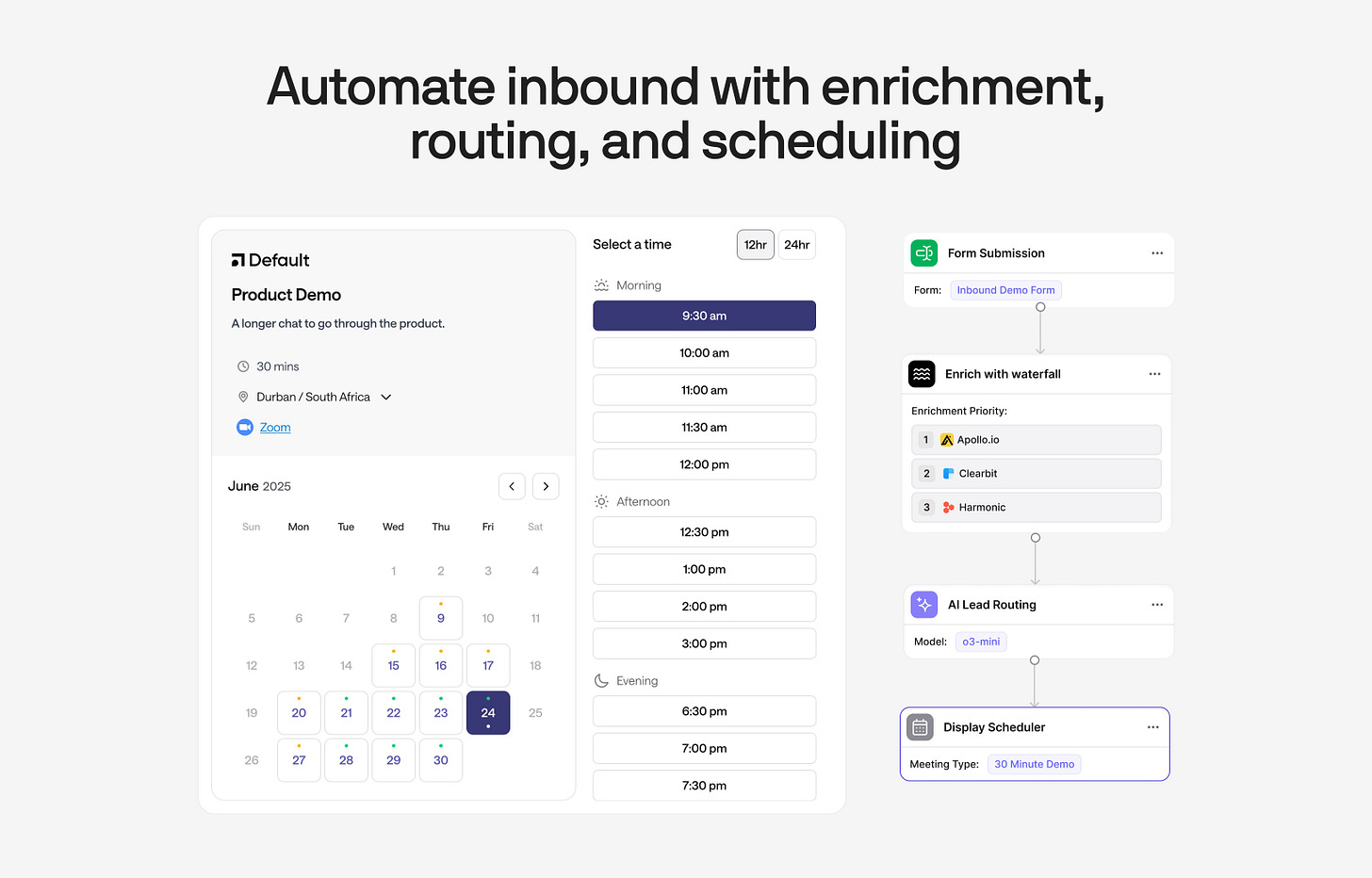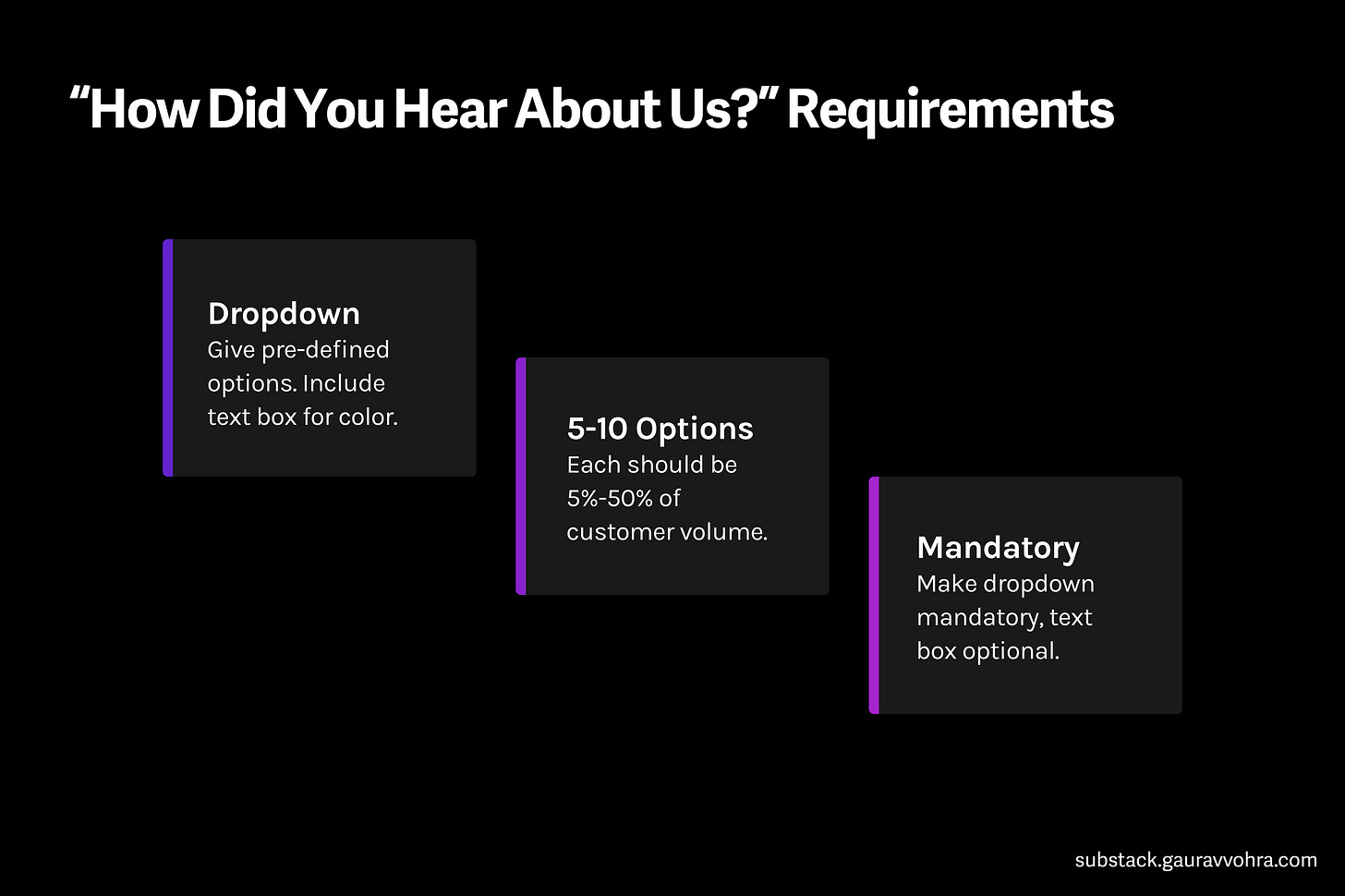How Did You Hear About Us?
The most useful data — that you're not gathering
Sponsored by Default.com. Founders, growth, and marketing teams at Unify, Hex, Pylon, and OpenPhone automate inbound with Default — an all-in-one platform that schedules, routes, and enriches leads in real-time, turning demo requests into qualified pipeline.
If you find this write-up useful, use Default to set up “How did you hear about us?” today.
There’s one question every startup should ask new customers.
But it’s astounding that so few do.
That question: “How did you hear about us?”
There are all sorts of ways to determine which channels are working: Referrer attributes, URL params, affiliate codes, Stripe coupons, Google Analytics, Google Search Console, CDN logs, Fivetran imports, DBT ELTs, ad platform dashboards, and much more.
That data can be assembled into an attribution model as gloriously complex as you can imagine.
But “How did you hear about us?”, or HDYHAU1, is a machete through the jungle of trying to figure out what's driving your growth.
Instead of spending weeks assembling disparate data sources, you can stand up HDYHAU in less than a day, and start using same week.
Every startup serious about growth should ask this simple question during signup.
Read this if you’re a founder, marketer, or in growth.
Requirements
Pre-defined options or a free text box?
TLDR: Pre-defined options. Include an optional free text box for added color.
Let’s explore this more comprehensively.
We should work back from the decisions that will be made. HDYHAU unlocks two grains of decision:
Strategic: Entire channels to further invest in or pull back on.
Tactical: Niche opportunities to further explore, such as a podcast or viral tweet that mentioned you.
Most of the value is in strategic decisions: For example, deciding to double down on paid and organic search, because a surprisingly high percentage of customers find you by searching.
Remaining value is in tactical decisions: For example, noting that there's a growing amount of “ChatGPT” in your "Search" bucket, so you might want to start investing in AEO (AI Engine Optimization), beyond SEO and SEM.
Given the strategic decisions you need to make, you'll want to periodically review a stacked bar chart2 that will start to look like this:
To make tactical decisions you will occasionally want to investigate more deeply to get a feel for underlying details, nuances, and trends.
What is the best way to get this data?
Pre-defined options most rapidly get you to the visual. The data collected is the data charted.
An optional free text box adds further signal and nuance.
Purists might argue that pre-defined options are a cludge and that all grains of signal can be extracted from a free text box.
While it is true that LLMs can mostly aggregate free text entries into broad buckets, this is a level of ongoing data manipulation beyond what most startups should spend time on when they're very early.
That said, an off-the-shelf LLM solution that is 95%+ reliable will exist within the next year. At that time, this recommendation will change.
How many options? What should they be?
TLDR: Anywhere from 5-10 works great.
They should more or less be:
Search
Worth of mouth
Social Media
Content
Ads
Other
For each area: Break out sub-channels if they are individually important to track:
Search might usefully be broken down into Google, Bing, ChatGPT, etc.
Word of mouth might split into Friend, Family, Colleague, etc.
Social Media might live across Instagram, X, TikTok, etc.
Content might be YouTube, newsletter, podcast, blog, etc.
Ads might be digital, broadcast, out-of-home, etc.
Of course, include any further but more niche channels that are relevant to your startup, such as influencers, customer review sites, events, etc.
Last, make sure you randomize the order to avoid the top option being over-represented.
Mandatory or optional?
TLDR: Mandatory.
While optional is fine, it will result in low coverage and data skew.
Lower intent channels like paid social will end up under-represented if the question is optional. And you won't know by how much.
Why flirt with ambiguity? Just make it mandatory: It takes customers five seconds.
Perhaps most important to dispel is the myth that asking people where they heard about you is going to destroy your signup conversion rate.
Any customer so low intent that they drop out at this step was never going to be a good customer in the first place.
I'm gathering data. Now what?
Visualize
Create a stacked bar over time.
You should look at two views: Absolute and Relative stacked to 100%.
Together they will look like this:
Make edits within the first few days of gathering data:
Get rid of options that are <5% by combining them (unless, of course, monitoring them is key to your strategy.)
Split apart options that are >50%.
Create options to keep “Other” to <5%.
The goal is to get a view that is detailed enough that you can make decisions, but coarse enough that it doesn't take forever to decipher.
Understand
First: Is the data what you expected? Where are numbers bigger or smaller than what you expected?
Most founders I advise are surprised at how “quiet” channels like Search are so big, and how “noisy” channels like Social Media are so small. Reflect on what you’ve learned from the data.
Next: If you’re gathering free text data, spend time more deeply exploring the data. Use an LLM or tool like Default to aggregate the data and double check your buckets.
Are there any notable sub-channels? Do any specific names get mentioned a lot?
Build a deep mental map of what is working for your company.
Quick Wins
If this is your first time looking at this data, chances are you are early in the journey of creating your marketing strategy. If so, there are probably some immediate quick wins:
In the context of HDYHAU, high volume is any channel above 20%.
Low cost, high volume: Double down
Deepen your investment in these channels and see how much volume you can drive at acceptable costs.Low cost, low volume: Autopilot
Let these channels hum along until you have enough capacity to drive them more.High cost, high volume: Optimize
These channels are working, but you can probably trim cost as you continue to push volume.High cost, low volume: Kill off
These channels are not working: Get rid of them.
Revisit
There are two lenses through which you’ll want to revisit HDYHAU:
New cohorts over time
Set up a cadence of glancing at HDYHAU every week or month (depending on how fast-moving your funnel is). Pay attention to any major channel shifts — expected or unexpected.Older cohorts aging
Over time you’ll build a robust picture of which channels lead to customers with the best and worst activation, monetization, retention, expansion, and more.
The latter is particularly illuminating. Some channels might be in the sweet spot of low cost, scalable, and result in the best downstream customer metrics.
Of course, it is extremely worthwhile to double down on these channels!
(Hint: it will be Word of Mouth.)
Limitations
Supplementation
HDYHAU is extremely useful, but it is far from a panacea.
Rand Fishkin outlines 2 criticisms here.
Human memory is fallible
Results might not accurately represent reality.Answers won't identify specific parts of the marketing journey
HDYHAU will not distinguish between when a new customer first heard about you (creating initial awareness) vs. when they most recently heard about you (resulting in them taking action), for example.
These are valid concerns to keep in mind.
That said, I vouch that for 90%+ of startups, the errors introduced from these inaccuracies are significantly less than the errors introduced by not having any visibility whatsoever — which is where most startups start.
Rand rightly argues for two further components to your attribution: Customer interviews, and passively collected data at scale.
By the time you are investing serious money in marketing — roughly speaking, over $50,000 per month — these should be “next up” on your marketing ops to-do list.
With a broader data pipeline in place, HDYHAU can be usefully merged into your attribution algorithm.
For example, between passive data collection and HDYHAU, you might learn the following for a single customer:
First touch: Referral from existing customer.
Middle touch: Clicked retargeting ad.
Last touch: Clicked organic search result.
HDYHAU: Social media.
Each startup might view this data in different ways, but a reasonable approach could be to allocate weight to the three channels of “word of mouth”, “paid social”, and “SEO” — with extra weight placed on “paid social”, thanks to HDYHAU.
Bigger picture
Rand also pushes on a higher altitude strategic consideration:
The people who didn’t reach you, the people who never heard about your company, can’t possibly tell you what they pay attention to that you’re missing out on.
So if you use “how did you hear about us?” to inform your marketing efforts, what will happen?
You will only ever invest in the kinds of marketing that have already been successful for you in the past. And you won’t find new channels and sources.
This is correct. So, once you’ve done the quick wins, take a step back and look at HDYHAU as one of several inputs to your marketing strategy. Consider running an exercise like The Unfair Advantages Framework with HDYHAU in mind.
And remember, the beauty of HDYHAU is it is:
Something you can stand up in less than a day.
Something you can start using same week.
Further reading:
Don’t reinvent user profiling during onboarding. This is what it should look like — Elena Verna
The 3 Big Problems with Asking “How Did You Hear About Us?” — Rand Fishkin
The State of Booking Inbound Demos: Insights from 51,219 Meetings — Default.com
Thanks to Preet Anand for draft input.
HDYHAU is pronounced: “Howdy, how.”










Most startups overthink attribution and underuse the one question that actually tells the truth.
High-signal. Low-cost.
Criminally underrated.
Great post.